Introduction
Fish is considered to be an excellent source of protein, low fat and essential micronutrients. The consumption of fish and its by-products is highly increased throughout the world. The nutritional values of fish flesh have a key role in food security and poverty alleviation in developing countries. Generally, animal protein provides high-grade protein when comparing with those of plant, meat, milk and egg. Researchers over the past few decades have confirmed the importance of the nutritional components of fish in the development of brain and described the role of fish in different body functions. It is also reported that the nutritional qualities of fish were very high thus making it an ideal source of important micro nutrients both for nourishment and medicinal purposes (Effiong & Mohammed, 2008).1
Cabdio ukhrulensis is a benthopelagic and freshwater fish species inhabiting streams and rivers of Manipur. Raiamas guttatus, locally known as Ngawa than-gong, is mainly found in the streams of Manipur valley and Chindwin drainage. It is a predatory fish, feeding on small fishes and insects and has ornamental values. Salmostoma sladoni is a benthopelagic freshwater fish inhabiting the clear streams and rivers of Myanmar and Manipur, India (Talwar & Jhingran, 1991).2 Schistura khugae, locally known as Ngatup, is a bottom dwelling hill stream freshwater fish reported from Chindwin drainage of Manipur and it also has ornamental values. Systomus clavatus, locally known as Nung-nga, is mainly distributed in Brahmaputra drainage of Manipur and Assam. It is also treated as a good food fish in Manipur. Tor tor, a freshwater fish locally known as Ngara, is widely distributed in both Barak and its tributaries and hill streams of Chindwin drainage. It is very popular and has high demand in the state for its good taste (Vishwanath, 2002).3
In spite of their diversity and importance as food for the local human populations, very little is known about the mineral composition of the freshwater fish species in the state considering the health-related benefits of fish minerals. Apart from fish being an excellent food for humans, it has immense value to the environmentalists and many researchers. The increase in health consciousness among the fish consumers have resulted in high concern about conserving fish. Many fish species are also in a highest degree of threat due to species invasion, pollution, over exploitation, habitat loss, construction of dams and many other modifications in the flow of rivers. Therefore, keeping in view of these facts, the present work is designed to assess the nutritional values and biochemical compositions of some freshwater fish species of Manipur.
Materials and Methods
Six different cyprinid fish species were collected from different hill districts of Manipur, India. Cabdio ukhrulensis (Fig. 1), Raiamas guttatus (Fig. 2) and Salmostoma sladoni (Fig. 3) were collected from the Moreh market located at Indo-Burma border, Chandel district. Tor tor (Fig. 4) and Systomus clavatus (Fig. 5) were collected from Bark River, Tamenglong district.; while Schistura khugae (Fig. 6) was collected from Itok River, Yairipok, Thoubal district. Their total length (cm) and weight (gm) were shown in Table 1
Table 1: Collection sites with their respective species
| Sl. no. | Sites | GPS location | Fish species | No of samples | TLa(cm) | Weight(g) |
| i. | Barak river, Tamenglong district | 93°28´E, 25°03´N | Tor torSystomus clavatus | 66 | 23-398.6-18.8 | 125-7856.4-31 |
| ii. | Moreh, Chandel district | 94°18´E, 24°14’N | Cabdio ukhrulensisRaiamas guttatusSalmostoma sladoni | 666 | 10-10.421.1-2210.1-10.8 | 7.23-891.98-94.029.3-10.9 |
| iii. | Itok river, Yairipok, Thoubal district | 94°07´E,24°42’N | Schistura khugae | 6 | 6.5-7.2 | 1.96-2.71 |
a TL: Ranges of total length of the samples collected. Only the similar sizes of samples were used for the analyses.
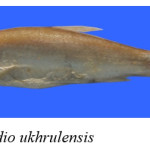 |
Figure 1: Cabdio ukhrulensis Click here to View figure |
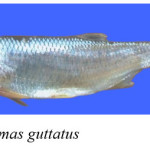 |
Figure 2: Raiamas guttatus Click here to View figure |
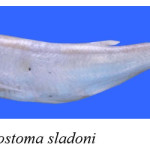 |
Figure 3: Salmostoma sladoni Click here to View figure |
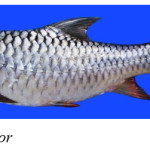 |
Figure 4: Tor tor Click here to View figure |
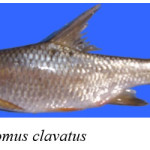 |
Figure 5: Systomus clavatus Click here to View figure |
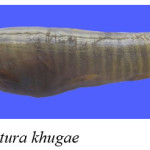 |
Figure 6: Schistura khugae Click here to View figure |
Fish samples were collected and stored in cold chain and brought to the Laboratory, Department of Life Sciences, Manipur University, Canchipur. Fishes were washed with running tap water; six number of each species of similar sizes were differentiated and their edible parts were homogenised separately in a mortar-pestle and used for various analyses.
Proximate Composition
Moisture was determined by using the methods of (AOAC, 2000).4 Total lipid was extracted by following the method of Singh et al., 1990.5 Total nitrogen content was estimated by the modified Micro-kjedahl method (AOAC, 2000).4 The samples were subjected to digestion using KELPLUS digestion chamber; nesslerization and finally absorbance of sample were measured in 440 nm using UV-Spectrophotometer (SHIMADZU, UV-1800, Kyoto, Japan) which were compared with standard concentration. Total protein values were obtained by multiplying the nitrogen value with 6.25 (Osborne et al., 1978).6 For the determination of ash content, moisture free samples were ignited at 500ºC in a muffle furnace for about 2-3 hours to obtained carbon free white ash as described by (AOAC, 2000).4
Total amino acids (TAA)
Total amino acid was determined by the method described by Moore and Stein (1948).7 Calculation of the amount of TAA was done by using standard curve prepared from leucine by pipetting out 0.1-1.0 ml (10-100µg range) of working standard solution. Results were expressed in mg/100g equivalent of leucine.
Mineral analysis
Essential mineral elements were analysed following the method of Perkin-Elmer, 1996.8 Accurately weighed ash of respective samples were digested in nitric acid (HNO3) and perchloric acid (HClO4) and make up to the volume of 50 ml distilled water and subjected to analyse the dissolved mineral content in Atomic Absorption Spectrophotometer (AAS)-203.
Statistical analysis
The data were analysed by subjecting to one-way ANOVA at P≤0.05 and the significance mean were compared by Duncan’s multiple range tests using SPSS 16.0 version and the data are presented as mean ± standard deviation. Pearson’s correlation coefficients were also calculated to describe the linear dependence of ash and minerals for the species.
Results and Discussion
Proximate composition and TAA of the six species were analysed and the results were shown in Table 2 and Fig. 7 respectively. The concentration levels of macro and micro elements among the species were also given in tables 3 and 4 respectively.
Proximate composition and Total amino acid (TAA)
The moisture, total lipid, total protein and ash of six cyprinid species are shown in Table 2. The moisture content among the species varied with a range of 72.39-76.43 % which is comparable with that of Sarojnalini and Vishwanath (1988).9 where the content was found ranging from 71.00 to 80.00 % in some fresh water fishes of Manipur. Ackman (1989)10 also reported that the moisture content in fish should be in the range of 70-80% of the total weight. The result in this study also showed that moisture is the main constituent of fish. The relative lipid content varied from one species to another and found ranged from 2.73 to 4.93 %. According to Ackman (1989),10 fish are generally classified into four categories based on their fat contents: lean fish (<2%), low fat (2-4%), medium fat (4-8%) and high fat (>8%). So, the species in this study falls into the group of low fat to medium fat categories. The differences in the fat content among the species might be due to the significant difference in the way of storing fat, fat accumulation during breeding season and decrease in fat accumulation after spawning (Nair & Mathew, 2000).11 The protein content in the present work was found in moderate to high percentage (5.99-26.24 %). Two species, Salmostoma sladoni (16.21%) and Tor tor (26.24%) belonged to the high protein fish category (>15%) according to the report of FAO (2016),12 and the rest can be considered as moderately high protein species. The relatively high to moderate percentage of protein could be attributed to the fact that fishes are good sources of animal protein, and the differences observed in the present study might be due to the consumption capability by the fishes from their diets (Burgress, 1975).13 Ash content ranged from 5.83-14.13 % and is positively correlated with certain mineral content, particularly calcium, magnesium, manganese and zinc with correlation coefficients of 0.77, 0.63, 0.29 and 0.32 respectively. The higher ash content in some species might be due to their bony consistency in edible parts.
Table 2: Proximate composition of the six freshwater fish species of Manipur
|
Proximate composition (% WWB) |
||||
| Species | Moisture | Total lipid | Total protein | Ash |
| Cabdio ukhrulensis | 73.03±0.19 | 3.93±0.15 | 12.38±0.36 | 11.85±0.11 |
| Raiamas guttatus | 72.43±0.02 | 2.83±0.15 | 10.13±0.18 | 14.13±0.21 |
| Salmostoma sladoni | 74.66±1.12 | 4.93±0.11 | 16.21±1.12 | 12.18±0.20 |
| Schistura khugae | 72.39±0.03 | 3.97±0.15 | 13.52±0.54 | 12.70±0.40 |
| Systomus clavatus | 75.58±0.40 | 2.73±0.21 | 5.99±0.05 | 7.87±0.21 |
| Tot tor | 76.43±0.15 | 4.70±0.36 | 26.24±0.62 | 5.83±0.42 |
Values are mean of 3 replicates
Mean ± S.D. followed the same letter are not significantly different (P≤0.05)
TAA content among the species varied greatly with a range of 229.50 to 720.75 mg/100g (Fig. 7). The highest content was recorded in the edible parts of Tor tor (720.75 mg/100g). The TAA content in the species is related with the increased or decreased in the availability of foods.
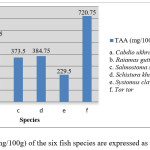 |
Figure 7: TAA contents (mg/100g) of the six fish species are expressed as mean of three replicates Click here to View figure |
Essential Mineral composition
The essential mineral content obtained in this study was compared against the report of FAO (2001)14 and the recommended dietary allowances (RDA) for an adult Indian have been shown in table 5. Food and Agricultural Organisation (FAO) mean ranges for fish composition have been included in the table to compare the result of this study with internationally accepted ranges of edible part of fish. The report of Recommended Dietary Allowances (RDA), 201015 is about the nutrient requirements and recommended dietary allowances for Indians published by the Indian Council of Medical research (ICMR), Hyderabad.
Calcium
Fish, especially the small indigenous species (SIS) is considered to be a good source of calcium (Roos et. al., 2003),16 because of their high bony nature. In this study, calcium content ranged considerably from 220.00-2023.00 mg/100g. The calcium content of Tor tor (220.00±1.41 mg/100g) and Cabdio ukhrulensis (860.94±1.33 mg/100g) were found within the range of 19.00-881.00 mg/100g as reported by FAO, 2001.14 While the calcium content of Systomus clavatus (1405.20±3.18 mg/100g), Schistura khugae (1598.50±4.00 mg/100g) and Raiamas guttatus (2023.50±4.24 mg/100g) were found within the range of 760.00-2200.00 mg/100g (Moeller et al., 2003).17 The recommended daily intake of calcium for adult Indian is 600-1200 mg/100g (RDA, 2010).15 The data mentioned here clearly indicates that they are good source of calcium and it can be assumed that regular consumption of these species will help in the strength of bones and teeth.
Table 3: Macro element content of the six fish species (mg/100g).
|
Macro elements (mg/100gm) |
||||
| Species | Ca | Mg | Na | K |
| Cabdio ukhrulensis | 860.94±1.33b | 120.60±0.92f | 87.50±0.19a | 100.00±0.25c |
| Raiamas guttatus | 2023.50±4.24f | 97.75±1.73d | 107.60±0.08c | 120.00±0.15e |
| Salmostoma sladoni | 1861.00±2.60e | 114.80±1.04e | 90.00±0.27a | 112.56±0.23d |
| Schistura khugae | 1598.50±4.00d | 91.00±1.75c | 89.17±1.40a | 24.92±0.38a |
| Systomus clavatus | 1405.20±3.18c | 74.25±2.00a | 100.00±2.46b | 132.50±0.29f |
| Tot tor | 220.00±1.41a | 81.50±1.14b | 100.00±2.39b | 75.00±0.52b |
Values are mean of 3 replicates
Mean ± S.D. followed the same letter are not significantly different (P≤0.05)
Magnesium, Sodium and Potassium
Magnesium concentration ranged from 74.25 to 120.60 mg/100g was reported among the species and is positively correlated with the ash content with correlation co-efficient of 0.63. These results are within the range as reported by FAO (2001)14 (4.50-452.00 mg /100g) and Moeller et. al., (2003)17 (27.00-140.00 mg/100g). The recommended daily intake of magnesium for adults in India is 540.00-1002.00 mg (RDA, 2010).15 The species in this study can contribute the requirement of magnesium to men’s diet to some extent as this mineral plays an active role in enzyme activity and an important component of bones and teeth (Murray et al., 2000).18 Sodium concentration in this study found ranged between 87-107 mg/100g, which falls within mean ranges of 30-134 mg/100g as reported by FAO (2001).14 The highest sodium content was recorded in Raiamas guttatus (107.60 mg/100g). The recommended dietary allowance for Indians is 1100-3300 mg/day according to RDA (2010).15 So, the fishes studied will provide a good source of sodium. The concentration of Potassium among the species ranged from 24-132 mg/100g, which falls within the mean ranges of 19-502 mg/100g as reported by FAO (2001).14 According to RDA (2010)15 recommended dietary intake of potassium by an adult Indian per day is 1875-5625 mg. The species in this study might not be a good source of this mineral but it can contribute in small quantity.
Manganese, copper, zinc and iron
The concentration levels of manganese among the fish studied ranging from 0.37-1.29 mg/100g, which again falls within the mean ranges of FAO (2001)14 (0.0003-25.2 mg/100g) and Moeller et al., (2003)17 (0.12-2.2 mg/100g). According to RDA (2010),15 the recommended dietary intake of manganese by an adult Indian is 2-5 mg/day. This mineral is a part of enzymes involved in urea formation, pyruvate metabolism and the galactotransferase of connective tissue biosynthesis (Chandra, 1990).19
Table 4: Micro element content of the six fish species mg/100g)
|
Micro elements (mg/100gm) |
||||
| Species | Mn | Cu | Zn | Fe |
| Cabdio ukhrulensis | 1.29±0.02f | 0.26±0.01b | 3.47±0.02f | 18.03±0.10c |
| Raiamas guttatus | 0.81±0.02c | 0.23±0.03ab | 1.44±0.02c | 24.69±0.07f |
| Salmostoma sladoni | 1.01±0.02e | 0.37±0.02c | 1.91±0.02d | 11.68±0.03b |
| Schistura khugae | 0.37±0.01a | 0.20±0.01a | 0.68±0.02b | 7.91±0.01a |
| Systomus clavatus | 0.86±0.16d | 0.19±0.60a | 1.99±0.17e | 19.36±0.17d |
| Tot tor | 0.45±0.01b | 0.41±0.15c | 0.23±0.02a | 21.23±0.05e |
Values are mean of 3 replicates
Mean ± S.D. followed the same letter are not significantly different (P≤0.05)
Copper is an essential micro-nutrient, helps in erythropoiesis, absorption of iron from the gastrointestinal tract and in the transfer of iron from tissues to the plasma (Malhotra, 199820; Murray et al., 200018). The copper concentration in the study was found ranging from 0.19-0.41 mg/100g, which found within the mean range of FAO (2001)14 (0.001-3.7 mg/100g) and Moeller et al., (2003)17 (0.17-0.6 mg/100g); and the recommended dietary intake of copper by an adult Indian is 2 mg/day (RDA, 2010).15 This shows that the copper content in this study is much lower than the recommended dietary intake of RDA (2010).15
Table 5: Comparison of mineral contents in the selected fish species with other studies
| Element | This study(mg/100g) | FAO 2001a (mg/100g) | RDA2010b (mg/day) |
| Ca | 220-2023 | 19-881 | 600-1200 |
| Mg | 74-120 | 4.5-452 | 540-1002 |
| Na | 87-107 | 30-134 | 1100-3300 |
| K | 24-132 | 19-502 | 1875-5625 |
| Mn | 0.37-1.29 | 0.0003-25.2 | 2-5 |
| Cu | 0.19-0.41 | 0.001-3.7 | 2 |
| Zn | 0.23-3.47 | 0.23-2.1 | 9.4-12.7 |
| Fe | 7.91-24.69 | 1-5.6 | 17-35 |
aFAO/WHO. 2001. Human vitamin and mineral requirements, Rome: FAO
bRDA. 2010. Nutrient requirements and recommended dietary allowances for Indians: A report. National Institute of Nutrition. ICMR, Hyderabad.
The primary roles of zinc appear to be in cell replication and gene expression and in nucleic acid and amino acid metabolism. It also plays an important role in the development of testicles (Merck, 1986)21. It is also an important constituent of plasma (Malhotra, 199820; Murray et al., 200018). In this study, zinc concentration was significantly found highest in Cabdio ukhrulensis (3.47±0.02 mg/100g). The levels of zinc concentration in this study is found well within the mean range of FAO (2001)14 (0.23-2.10 mg/100g) and that of Moeller et al., (2003)17 (0.32-6.60 mg/100g), and the recommended dietary intake of zinc by an adult Indian is 9.40-12.70 mg/day (RDA, 2010)15. Iron helps in the transport of oxygen in and around the body and its deficiency causes anaemia. The iron content in this study was found ranging from 7.91-24.69 mg/100g which is significantly high when compared with those of FAO, 200114 (1.00-5.60 mg/100g) and Moeller et al., 200317 (2.30-9.00 mg/100g) and the recommended dietary intake of this mineral by an adult Indian is 17.00-35.00 mg/day (RDA, 2010)15. These fish species will provide a good source of iron in one’s diet.
Conclusion
This study will provide a baseline data on proximate composition, TAA and essential mineral composition of some cyprinid species of Manipur. These fish species are significant sources of protein and essential mineral elements (especially calcium, magnesium, manganese and iron) and they will provide good nutrition to the people of the region, especially to the rural people of low-income groups. They might contribute to food security, as a source of protein and essential mineral elements. This study shows that fish contribute more to people’s diet than just the high quality protein they are so well known for. Therefore, fish should be included in the diet to prevent malnutrition by making these essential mineral elements readily available to our body. To utilize the potential of fresh water fish species for improving micronutrient deficiencies, measures should be taken to conserve them at the highest degree. The findings of this study could be useful to the people of the region regarding the nutritional significance of consuming fish.
Acknowledgments
The authors thank to the Head of the Department, Department of Life Sciences, Manipur University and Dr. N. Sanamacha Meetei, R&D Lab., Directorate of Environment, Government of Manipur for providing laboratory facilities. They also greatly appreciate the colleagues of the Fishery Research Laboratory for giving cooperation during the entire work was done.
References
- Effiong BN and Mohammed I. Effect of seasonal variation on the nutritional composition in selected fish species in Lake Kainji, Nigeria. Nature and Science. 6(2): (2008).
- Talwar PK and Jhingran, AG. Inland Fishes of India and Adjacent Countries.A. Balkema/Rotterdam (1991).
- Vishwanath W. Fishes of North East India: A field guide to species identification. National Agricultural Technology Project. Department of Life Sciences Manipur University (2002).
- Official Methods of Analysis, 16th Edn. Association of official Analytical Chemists, Washington D.C. (2000).
- Singh B, Sarojnalini CH and Vishwanath W. Nutritive values of sundried Esomus danricus and smoked Lepidocephalus guntea. Food Chem. 36:89-96: (1990).
CrossRef - Osborne, DR and Voogt, TP. Analysis of nutrients in foods. Academia Press, New York (1978).
- Moore S and WH Stein. In: Methods Enzymol. (Eds. Colowick, S.P and Kaplan, N.D), Academic press, New York, 3, 468:9(1):1-5: (1948).
- Perkin-Elmer. Analytical Methods for Atomic Absorption Spectroscopy. The Perkin-Elmer Inc. U.S.A (1996).
- Sarojnalini C and Vishwanath W. Studies on the biochemical composition of some freshwater fishes of Manipur. Adv. Zoo. 4(1):1-5: (1988).
- Ackman RG. Nutritional composition of fats in seafoods, Food Nutr. Sci. 13(3-4): 161-241: (1989).
- Nair PGV and Mathew, S. Biochemical composition of fish and shell fish, Central Institute of Fisheries Technology, Cochin-682029, ICAR (2000).
- Nutritional elements of fish, FAO-Fisheries and Aquaculture Department (2016).
- Burgress GHO. Increasing the direct consumption of fish. In: Pirie WW (Edu). Food Protein Sources. International Biological Program 4. Cambridge University Press, Cambridge. 187-200: (1975).
- FAO/WHO. Human vitamin and mineral requirements, Rome: FAO (2001).
- Nutrient requirements and recommended dietary allowances for Indians: A report. National Institute of Nutrition. Indian Council of Medical Research, Hyderabad (2010).
- Roos N, Mohammed MI and Shakuntala HT. Small Indigenous Fish Species in Bangladesh: Contribution to Vitamin A, Calcium and Iron Intakes. Journal of Nutrition 133:4021S–4026S: (2003).
CrossRef - Moeller A, MacNeil SD, Ambrose RF, Hee SSQ. Elements in fish of Malibu Creek and Malibu Lagoon near Los Angeles, California. Pollut. Bull. 46:424-429: (2003).
CrossRef - Murray RK, Granner DK, Mayes PA and Rodwell VW. Harper’s Biochemistry, 25th, McGraw-Hill, Health Profession Division, USA (2000).
- Chandra RK . Micro-nutrients and immune functions: An overview. Ann. N.Y. Acad. Sci. 587:9-16: (1990).
CrossRef - Malhotra V. Biochemistry for Students. 10th Jaypee Brothers Medical Publishers (P) Ltd. New Delhi, India (1998).
- Merck VM. The Merck Veterinary Manual. 6th Edn. A handbook of diagnosis, therapy and disease prevention and control for the veterinarian. Published by Merck and Co., Inc., Rahway, New Jersey, USA (1986).

This work is licensed under a Creative Commons Attribution 4.0 International License.






